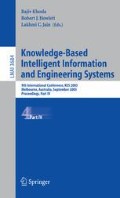Abstract
This paper describes a classification criteria-structuring method for handling exception cases. Clustering technology is utilized to classify large amounts of data effectively. In current clustering technology, however, it is impossible for a system to classify all data completely, due to exceptions in the data. In an ubiquitous computing environment, exceptions arise due to changes in the environment. We propose an architecture in which the system changes classification criteria and rules using constructive induction.
Access this chapter
Tax calculation will be finalised at checkout
Purchases are for personal use only
Preview
Unable to display preview. Download preview PDF.
References
Kamishima, T., Motoyoshi, F., Akahori, S.: Learning from Cluster Examples–Employing Attributes of Clusters. Transactions of the Japanese Society for Artificial Intelligence 18(2), 86–95 (2003) (in Japanese)
Kamishima, T., Motoyoshi, F., Akahori, S.: Learning from Cluster Examples. Journal of the Japanese Society for Artificial Intelligence 12(2), 276–284 (1997) (in Japanese)
Kamishima, T., Motoyoshi, F.: Learning from Cluster Examples. Machine Learning 53, 199–233 (2003)
Tsuda, H.: What is support vector machine. Journal of the Institute of Electronics, Information and Communication Engineers 83(6), 460–466 (2000) (in Japanese)
Sugaya, S., Suzuki, E.: Normal form conversion and object recognition by Support Vector Machines. In: Proceedings of the Japanese Society for Artificial Intelligence National Conference, June 1999, pp. 476–479 (1999) (in Japanese)
Kira, K., Rendell, L.: A practical approach to feature selection. In: Proceedings of the 9th International Conference on Machine Learning (1992)
Taki, H.: Constructive Inductive Learning and Bias. Journal of the Japanese Society for Artificial Intelligence 9(6), 818–822 (1994) (in Japanese)
Author information
Authors and Affiliations
Editor information
Editors and Affiliations
Rights and permissions
Copyright information
© 2005 Springer-Verlag Berlin Heidelberg
About this paper
Cite this paper
Yamamoto, T., Taki, H., Matsuda, N., Miura, H., Hori, S., Abe, N. (2005). Constructive Induction-Based Clustering Method for Ubiquitous Computing Environments. In: Khosla, R., Howlett, R.J., Jain, L.C. (eds) Knowledge-Based Intelligent Information and Engineering Systems. KES 2005. Lecture Notes in Computer Science(), vol 3684. Springer, Berlin, Heidelberg. https://doi.org/10.1007/11554028_20
Download citation
DOI: https://doi.org/10.1007/11554028_20
Publisher Name: Springer, Berlin, Heidelberg
Print ISBN: 978-3-540-28897-8
Online ISBN: 978-3-540-31997-9
eBook Packages: Computer ScienceComputer Science (R0)

